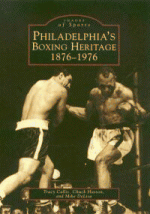[Previous entry: "John Ruiz is 'Number One' in Eyes of WBA"] [Main Index] [Next entry: "'Fight Club' Returns this Friday Night in Chicago!"]
05/30/2006 Archived Entry: "Judging Heavyweights"
Judging Heavyweights
by Tom Donelson
Courtesy of Boxing Press
Judging heavyweights is one of the more difficult aspects of any boxing historians. It is easier to rate middleweights from different era since there is a set weight for the division. Heavyweights are totally different since heavyweights have become bigger, in particular over the past three decades.
Between 1900 and 2000, the average American male grew 3 inches. Better diet along with new training methods has increased the average American athlete weight. So in measuring heavyweights from different era, this factor must be considered. Consider Rocky Marciano and Mike Tyson. Both fighters were essentially the same height but Rocky Marciano weighed 190 pounds whereas Mike Tyson fought close to 220 pounds at his peak three decades later. Could we assume, for argument sake, that Marciano may have weighed close to 220 if he fought three decades later?
When Jack Johnson and James Jefferies fought, they were both tall for their era and often out weighed their opponents. Today, they would actually be small heavyweights. If natural progression is any guide, Joe Louis may have fought at 240 pounds today as oppose to the 200 pounds that he actually fought at his peak in the early 1940's. So it might be beneficial to ignore height and weight when trying to compare heavyweights from different era.
So how do we compare heavyweights from different eras? One is simply to compare how each fighter fought against different styles and size. Joe Louis fought five fights against three fighters who were between 6'4" and 6'6" and he won all of these fights by knockouts. Louis often had trouble with cute boxers such as Billy Conn and Jersey Joe Walcott but he found a way to win against all styles. Ali also proved victorious against all styles but like Louis, he did better against certain styles over others. Ali easily beat heavy-handed sluggers just as George Foreman and Sonny Liston but had trouble with Joe Frazier, who extended Ali to 41 rounds of the toughest rounds ever fought in boxing history.
Jack Dempsey made his fame by beating a super heavyweight in Jess Willard and stopped another big heavyweight, Luis Firpo, within three rounds. In 1923, slick boxing Tom Gibbons lasted 15 rounds with Dempsey and the superior boxer, Gene Tunney, embarrassed Dempsey over two fights. Many boxing historians would argue that Dempsey was an old fighter due to a three-year absence from the ring. Yet, Dempsey was 31 years old and only three years older than Tunney. Ali recaptured the heavyweight title despite a similar three-year absence. He defeated Frazier in their second fight before upsetting a younger George Foreman in the Rumble in the Jungle. It could easily be argued that Dempsey would have easily handled Tunney at his peak but it could also be argued that Dempsey was not that far from his peak when he fought Tunney in 1926. It was universally accepted that Tunney won almost every round against Dempsey in their two fights. This despite the famous long count in the seventh round of their second fight.
Here is another way to look at Ali and his place in boxing history. He fought in the deepest Heavyweight era and he took five of six fights against Sonny Liston, George Foreman and Joe Frazier. And he was the underdog against both Liston and Foreman! Dempsey toughest opponent may have been Tunney and Tunney beat him soundly twice. So this would be a big factor in judging Ali and Dempsey place in heavyweight rankings.
Another indicator is the number of heavyweight championship fights won by a fighter. Joe Louis greatness is measured by the fact that he won 25 heavyweights titles bout. This indicates that Louis beat all comers and different styles. Another fighter who won a ton of title bouts was Larry Holmes, who won 21 championship bouts in a row before losing to Michael Spinks at the age of 36. Holmes, like Ali and Louis, showed that he could defeat a variety of styles and maintain excellence over period of years.
Judging Heavyweights is a difficult process since today's heavyweights are both taller and weigh more than previous generation. There are many ways to even out this evolution of height and weight that has occurred over the past century. Did fighters find a way to defeat a variety of styles of fighters? How many championship bouts did they win and how long did they stay at the top of their division? Did they have durability? How deep was the division they fought in? These are just some of the factors that can used in ranking Heavyweights.

